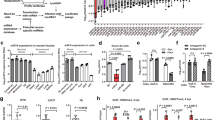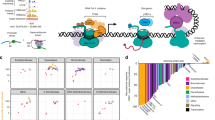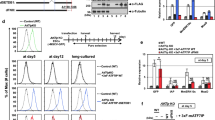Abstract
The repressor element 1 (RE1) silencing transcription factor/neuron-restrictive silencing factor (REST/NRSF) modulates the expression of genes with RE1/neuron-restrictive silencing element (RE1/NRSE) sites by recruiting the switch independent 3 (SIN3) factor and the REST corepressor (COREST) to its N and C-terminal repressor domain, respectively. Both, SIN3 and COREST assemble into protein complexes that are composed of multiple subunits including a druggable histone deacetylase (HDAC) enzyme. The SIN3 core complex comprises the eponymous proteins SIN3A or SIN3B, the catalytically active proteins HDAC1 or HDAC2, the histone chaperone retinoblastoma-associated protein 46/retinoblastoma-binding protein 7 (RBAP46/RBBP7) or RBAP48/RBBP4, the SIN3-associated protein 30 (SAP30), and the suppressor of defective silencing 3 (SDS3). Here, we overcome a bottleneck limiting the molecular characterization of the REST/NRSF–SIN3 transcriptional corepressor complex. To this end, SIN3 genes were amplified from the complementary DNA of neural stem/progenitor cells, and expressed in a baculovirus/insect cell expression system. We show that the isolates bind to DNA harboring RE1/NRSE sites and demonstrate that the histone deacetylase activity is blocked by small-molecule inhibitors. Thus, our isolates open up for future biomedical research on this critical transcriptional repressor complex and are envisioned as tool for drug testing.





Similar content being viewed by others
Abbreviations
- aa:
-
Amino acid
- CE:
-
Cytoplasmic extract
- EDTA:
-
Ethylenediaminetetraacetic acid
- HAT:
-
Histone acetyl transferase
- HDAC:
-
Histone deacetylase
- kDa:
-
Kilo Dalton
- NE:
-
Nuclear extract
- NRSE:
-
Neuron-restrictive silencing element
- NRSF:
-
Neuron-restrictive silencer factor
- PAGE:
-
Polyacrylamide gel electrophoresis
- PAH:
-
Paired amphipathic helix
- RBAP46:
-
Retinoblastoma-associated protein 46
- RBAP48:
-
Retinoblastoma-associated protein 48
- RBBP7:
-
Retinoblastoma-binding protein 7
- RBBP4:
-
Retinoblastoma-binding protein 4
- RE1:
-
Repressor element 1
- REST:
-
Repressor element 1 silencing transcription factor
- SAP30:
-
SIN3-associated protein 30
- SID:
-
Sin3 interacting domain
- SIN3:
-
Switch independent 3
- SDS:
-
Sodium dodecyl sulfate
- SDS3:
-
Suppressor of defective silencing 3
- TBE:
-
Tris/borate/EDTA
- WD:
-
Tryptophan-aspartic acid
- ZF:
-
Zinc finger
References
Kingston, R. E., & Narlikar, G. J. (1999). ATP-dependent remodeling and acetylation as regulators of chromatin fluidity. Genes & Development, 13, 2339–2352.
Kwon, H., Imbalzano, A. N., Khavari, P. A., Kingston, R. E., & Green, M. R. (1994). Nucleosome disruption and enhancement of activator binding by a human SW1/SNF complex. Nature, 370, 477–481.
Laherty, C. D., Yang, W. M., Sun, J. M., Davie, J. R., Seto, E., et al. (1997). Histone deacetylases associated with the mSin3 corepressor mediate mad transcriptional repression. Cell, 89, 349–356.
Lee, D. Y., Hayes, J. J., Pruss, D., & Wolffe, A. P. (1993). A positive role for histone acetylation in transcription factor access to nucleosomal DNA. Cell, 72, 73–84.
Garcia-Ramirez, M., Rocchini, C., & Ausio, J. (1995). Modulation of chromatin folding by histone acetylation. Journal of Biological Chemistry, 270, 17923–17928.
Hassig, C. A., Fleischer, T. C., Billin, A. N., Schreiber, S. L., & Ayer, D. E. (1997). Histone deacetylase activity is required for full transcriptional repression by mSin3A. Cell, 89, 341–347.
Gregoretti, I. V., Lee, Y. M., & Goodson, H. V. (2004). Molecular evolution of the histone deacetylase family: Functional implications of phylogenetic analysis. Journal of Molecular Biology, 338, 17–31.
Zhang, Y., Ng, H. H., Erdjument-Bromage, H., Tempst, P., Bird, A., et al. (1999). Analysis of the NuRD subunits reveals a histone deacetylase core complex and a connection with DNA methylation. Genes & Development, 13, 1924–1935.
You, A., Tong, J. K., Grozinger, C. M., & Schreiber, S. L. (2001). CoREST is an integral component of the CoREST- human histone deacetylase complex. Proceedings of the National Academy of Sciences of the United States of America, 98, 1454–1458.
Grimes, J. A., Nielsen, S. J., Battaglioli, E., Miska, E. A., Speh, J. C., et al. (2000). The co-repressor mSin3A is a functional component of the REST-CoREST repressor complex. Journal of Biological Chemistry, 275, 9461–9467.
Chong, J. A., Tapia-Ramirez, J., Kim, S., Toledo-Aral, J. J., Zheng, Y., et al. (1995). REST: A mammalian silencer protein that restricts sodium channel gene expression to neurons. Cell, 80, 949–957.
Schoenherr, C. J., & Anderson, D. J. (1995). The neuron-restrictive silencer factor (NRSF): A coordinate repressor of multiple neuron-specific genes. Science, 267, 1360–1363.
Lunyak, V. V., Burgess, R., Prefontaine, G. G., Nelson, C., Sze, S. H., et al. (2002). Corepressor-dependent silencing of chromosomal regions encoding neuronal genes. Science, 298, 1747–1752.
Ballas, N., Grunseich, C., Lu, D. D., Speh, J. C., & Mandel, G. (2005). REST and its corepressors mediate plasticity of neuronal gene chromatin throughout neurogenesis. Cell, 121, 645–657.
Ayer, D. E., Lawrence, Q. A., & Eisenman, R. N. (1995). Mad-Max transcriptional repression is mediated by ternary complex formation with mammalian homologs of yeast repressor Sin3. Cell, 80, 767–776.
Zhang, Y., Iratni, R., Erdjument-Bromage, H., Tempst, P., & Reinberg, D. (1997). Histone deacetylases and SAP18, a novel polypeptide, are components of a human Sin3 complex. Cell, 89, 357–364.
Alland, L., David, G., Shen-Li, H., Potes, J., Muhle, R., et al. (2002). Identification of mammalian Sds3 as an integral component of the Sin3/histone deacetylase corepressor complex. Molecular and Cellular Biology, 22, 2743–2750.
Zhang, Y., Sun, Z. W., Iratni, R., Erdjument-Bromage, H., Tempst, P., et al. (1998). SAP30, a novel protein conserved between human and yeast, is a component of a histone deacetylase complex. Molecular Cell, 1, 1021–1031.
Clark, M. D., Marcum, R., Graveline, R., Chan, C. W., Xie, T., et al. (2015). Structural insights into the assembly of the histone deacetylase-associated Sin3L/Rpd3L corepressor complex. Proceedings of the National Academy of Sciences of the United States of America, 112, E3669-3678.
Marks, P. A., & Breslow, R. (2007). Dimethyl sulfoxide to vorinostat: Development of this histone deacetylase inhibitor as an anticancer drug. Nature Biotechnology, 25, 84–90.
Nakajima, H., Kim, Y. B., Terano, H., Yoshida, M., & Horinouchi, S. (1998). FR901228, a potent antitumor antibiotic, is a novel histone deacetylase inhibitor. Experimental Cell Research, 241, 126–133.
Fournel, M., Bonfils, C., Hou, Y., Yan, P. T., Trachy-Bourget, M. C., et al. (2008). MGCD0103, a novel isotype-selective histone deacetylase inhibitor, has broad spectrum antitumor activity in vitro and in vivo. Molecular Cancer Therapeutics, 7, 759–768.
Duvic, M., & Dimopoulos, M. (2016). The safety profile of vorinostat (suberoylanilide hydroxamic acid) in hematologic malignancies: A review of clinical studies. Cancer Treatment Reviews, 43, 58–66.
Kwon, Y. J., Petrie, K., Leibovitch, B. A., Zeng, L., Mezei, M., et al. (2015). Selective inhibition of SIN3 corepressor with avermectins as a novel therapeutic strategy in triple-negative breast cancer. Molecular Cancer Therapeutics, 14, 1824–1836.
Bantscheff, M., Hopf, C., Savitski, M. M., Dittmann, A., Grandi, P., et al. (2011). Chemoproteomics profiling of HDAC inhibitors reveals selective targeting of HDAC complexes. Nature Biotechnology, 29, 255–265.
Jayaprakash, S., Drakulic, S., Zhao, Z., Sander, B., & Golas, M. M. (2019). The ATPase BRG1/SMARCA4 is a protein interaction platform that recruits BAF subunits and the transcriptional repressor REST/NRSF in neural progenitor cells. Molecular and Cellular Biochemistry, 461, 171–182.
Lin, L., Yuan, J., Sander, B., & Golas, M. M. (2015). In vitro differentiation of human neural progenitor cells into striatal GABAergic neurons. Stem Cells Translational Medicine, 4, 775–788.
Golas, M. M., Jayaprakash, S., Le, L. T. M., Zhao, Z., Huertas, V. H., et al. (2018). Modulating the expression strength of the baculovirus/insect cell expression system: A toolbox applied to the human tumor suppressor SMARCB1/SNF5. Molecular Biotechnology, 60, 820–832.
Inui, K., Zhao, Z., Yuan, J., Jayaprakash, S., Le, L. T. M., et al. (2017). Stepwise assembly of functional C-terminal REST/NRSF transcriptional repressor complexes as a drug target. Protein Science, 26, 997–1011.
Wegener, D., Wirsching, F., Riester, D., & Schwienhorst, A. (2003). A fluorogenic histone deacetylase assay well suited for high-throughput activity screening. Chemistry & Biology, 10, 61–68.
R Development Core Team (2013) R: A language and environment for statistical computing, in R foundation for statistical computing, Vienna, Austria
Lonsdale, J., Thomas, J., Salvatore, M., Phillips, R., Lo, E., et al. (2013). The genotype-tissue expression (GTEx) project. Nature Genetics, 45, 580–585.
Zhang, Y., Hu, W., Shen, J., Tong, X., Yang, Z., et al. (2011). Cysteine 397 plays important roles in the folding of the neuron-restricted silencer factor/RE1-silencing transcription factor. Biochemical and Biophysical Research Communications, 414, 309–314.
Struhl, K. (1998). Histone acetylation and transcriptional regulatory mechanisms. Genes & Development, 12, 599–606.
Laugesen, A., & Helin, K. (2014). Chromatin repressive complexes in stem cells, development, and cancer. Cell Stem Cell, 14, 735–751.
Huang, Y., Myers, S. J., & Dingledine, R. (1999). Transcriptional repression by REST: Recruitment of Sin3A and histone deacetylase to neuronal genes. Nature Neuroscience, 2, 867–872.
Nomura, M., Uda-Tochio, H., Murai, K., Mori, N., & Nishimura, Y. (2005). The neural repressor NRSF/REST binds the PAH1 domain of the Sin3 corepressor by using its distinct short hydrophobic helix. Journal of Molecular Biology, 354, 903–915.
Mori, N., Schoenherr, C., Vandenbergh, D. J., & Anderson, D. J. (1992). A common silencer element in the SCG10 and type II Na+ channel genes binds a factor present in nonneuronal cells but not in neuronal cells. Neuron, 9, 45–54.
Viiri, K. M., Janis, J., Siggers, T., Heinonen, T. Y., Valjakka, J., et al. (2009). DNA-binding and -bending activities of SAP30L and SAP30 are mediated by a zinc-dependent module and monophosphoinositides. Molecular and Cellular Biology, 29, 342–356.
Xie, T., He, Y., Korkeamaki, H., Zhang, Y., Imhoff, R., et al. (2011). Structure of the 30-kDa Sin3-associated protein (SAP30) in complex with the mammalian Sin3A corepressor and its role in nucleic acid binding. Journal of Biological Chemistry, 286, 27814–27824.
Acknowledgements
We are grateful to Golshah Ayoubi and Susanne N. Stubbe for excellent technical assistance, and wish to thank Zongpei Zhao for technical support. We acknowledge access to laboratory facilities at the Danish Neuroscience Center House. This work has been supported by the Lundbeck Foundation’s Fellowship program, the Sapere Aude Program of the Danish Council for Independent Research, the Danish Cancer Society, the Carlsberg Foundation, the A.P. Møller Foundation for the Advancement of Medical Sciences, the Fabrikant Einar Willumsens Mindelegat and the Helga og Peter Kornings Fond to M.M.G.
Author information
Authors and Affiliations
Corresponding author
Ethics declarations
Conflict of interest
The authors declare no conflict of interest related to this study.
Additional information
Publisher's Note
Springer Nature remains neutral with regard to jurisdictional claims in published maps and institutional affiliations.
Electronic supplementary material
Below is the link to the electronic supplementary material.
Rights and permissions
About this article
Cite this article
Jayaprakash, S., Le, L.T.M., Sander, B. et al. Expression of the Neural REST/NRSF–SIN3 Transcriptional Corepressor Complex as a Target for Small-Molecule Inhibitors. Mol Biotechnol 63, 53–62 (2021). https://doi.org/10.1007/s12033-020-00283-7
Accepted:
Published:
Issue Date:
DOI: https://doi.org/10.1007/s12033-020-00283-7




